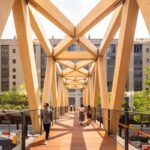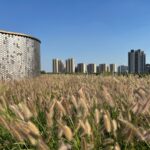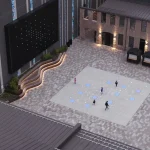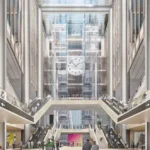Queens Plaza New York, Long Island City Landscape Architecture Design
Queens Plaza Improvement Project, New York : Long Island City
NY Landscape Architecture – various architects / designers
Sep 26, 2012
Queens Plaza Improvement Project New York
New York Landscape Architecture
Design Team: Margie Ruddick – Landscape Designer Sandro Marpillero, Linda Pollak – Architects and Urban Designers Leni Schwendinger – Lighting Designer Michael Singer – Artist
COMPLETION OF $45 MILLION QUEENS PLAZA IMPROVEMENT PROJECT TRANSFORMS A TANGLE OF INFRASTRUCTURE AND ASPHALT INTO A SUSTAINBLE, URBAN DESIGNED DESTINATION
September 26, 2012 (New York) – The completion of the $45 million Queens Plaza Improvement Project in Long Island City has transformed the primary entry point into the New York City borough of Queens into a sustainable, urban designed destination for pedestrians and cyclists.
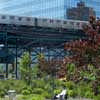
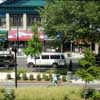
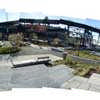
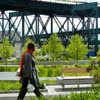
photos : Marpillero Pollak Architects
A team led by landscape designer Margie Ruddick, in collaboration with architectural firm Marpillero Pollak Architects and artist Michael Singer, focused their work on the integration of ecology, infrastructure, and art. The project was overseen by the Department of City Planning and the New York City Economic Development Corporation (NYCEDC).
The New York City Department of Planning initiated the project to transform what was an inhospitable tangle of infrastructure into a welcoming urban, pedestrian and cyclist-friendly area uniting the surrounding neighborhoods and restoring the connection between the city and the river.
The new urban designed landscape runs from Sunnyside Yards and Northern Boulevard to just beyond the Queensboro Bridge, moving from a new park space recently renamed Dutch Kills Green along a new corridor for cyclists and pedestrians within the roadway zone, where dense linear plantings buffer noise and pollution from the roadbed. The designed area continues just beyond an improved cyclist and pedestrian entry to the Queensboro Bridge at the site’s western end.
As landscape designer Margie Ruddick explains, “The idea that something hard, urban and harsh can operate ecologically is something that isn’t yet in the everyday language of landscape architecture. The design team found a language through which lushness and beauty could coexist with the hard edge of infrastructure.”
The design provides new crosswalks, restoring connections between the neighborhoods to the north and the south. Improved traffic signal times also create a safer and more navigable experience for pedestrians. The overall design is a pioneering urban landscape design that fulfills the City’s High Performance Infrastructure Guideline’s author’s call for landscapes that “store and clean water, filter air, help improve public health, and provide habitat and biotic connectivity to increase biodiversity, in essence to become organic infrastructure.”
The new urban landscape operates as a street network and also as a public park. The visionary design exceeds the usual park design, serving pedestrians, cyclists, motor vehicle drivers and subway passengers equally. The design is humane, serving the many ways people use the space; artful, integrating art and craft into every element of the design; and sustainable, as a pilot project for the City’s High Performance Infrastructure Guidelines, not only improving the environment but also participating in the daily functioning of the city.
The design team considered as an equally important component of sustainable design the integration of public art. Landscape designer Margie Ruddick collaborated closely with Marpillero Pollak Architects and Michael Singer Studio on the design of benches, pavers, and curbing, much of which was hand crafted by Michael Singer at his Vermont studio.
The close collaboration between designers, artists and engineers has resulted in world class landscape details. The artist-designed pavers and curbs direct storm water into the constructed wetland and the steel curbs along the roadway rise from the standard six inches to a height of three feet, mitigating the noise from roadway traffic. Equally relevant is that artful lighting by Leni Schwendinger of Light Projects makes this a compelling destination at night as well as during the day.
The project followed closely a rezoning effort led by the Department of City Planning to transform Queens Plaza into an appealing mixed-use neighborhood, but building on the industrial character of the area. Queens Plaza is notorious for its sixteen lanes of traffic, multiple above ground subway lines that rumble noisily overhead, and the industrial character of the area. The rezoning effort was accompanied by revitalization efforts to appeal to residents, business owners, pedestrians and transit riders.
The sustainable, urban designed landscape responds to the three goals of sustainable design being environmental, social and economic health.
Environmental sustainability:
The Queen’s Plaza landscape is constructed to be resilient in the face of climate change, integrating vegetation to cool air and bolster biodiversity, and innovative storm-water management solutions. The landscape features hundreds of new trees and shrubs, a constructed wetland that filters storm water and directs it down to recharge the groundwater, and permeable pavements that reduce the heat-island effect.
The drought-tolerant plantings include a long arc of Hornbeam trees mirroring the arc of the elevated subway line; a meandering “river” of understory trees and shrubs; and an array of perennials and groundcovers offering seasonal interest as well as increased comfort.
The design called for reusing materials such as the concrete removed from the roadbed to make way for this new park, demonstrating an approach to sustainable infrastructure that promotes salvage, recycling and reuse.
Social sustainability:
The Queen’s Plaza landscape provides a new cyclist and pedestrian infrastructure embedded in a neighborhood/community, serving social functions at the same time as it operates as a refuge. Rather than operating separately from the daily flow of people at street level, it creates a more livable city for residents and commuters.
The design of Dutch Kills Green highlights two historic millstones, previously embedded in a traffic island. The millstones serve as a link to Queens’ and New York City’s agricultural and industrial past.
Economic sustainability:
The Queen’s Plaza project is one of the few fully publicly funded landscapes completed in recent years, and is maintained by the Department of Parks. The design met the budget goals of the city, and fell within the parameters of the capabilities of a City agency to maintain it.
The project has attracted businesses such as Jet Blue to relocate and invest in the neighborhood, providing jobs and a vested interest in its public space. Queens Plaza and Dutch Kills Green have been identified by sustainable design expert Hillary Brown as one of the public works projects that may reset the course for strategic public investments.
She cites the project as an example of “environmentally and socially sound infrastructure designed to make positive contributions to our communities and neighborhoods,” and one of her envisioned “unprecedented new cross-sector collaborations to create smart, high performance public works.” Queens Plaza opened with great fanfare over a century ago as the formal gateway to Queens but then suffered years of neglect as vehicular traffic and noise from the elevated overwhelmed the pedestrian experience, once again serves as an inviting entry point to the borough.
This re-envisioned gateway to Queens was made possible by $25 million in New York City funds and $20 million in federal funding through Congresswoman Carolyn B. Maloney. The New York City Department of Parks & Recreation will maintain the park, medians and streetscape improvements with funding provided by the Long Island City Partnership, NYCEDC, and Met Life. The open space is formally sponsored by MetLife for the next ten years.
Margie Ruddick is recognized internationally for her environmental approach to urban landscape design. She has pioneered a design language that integrates ecology, urban planning and culture.
Marpillero Pollak Architects is a multi-disciplinary design practice spanning architecture and urban design, acclaimed for the skill with which their innovative design ideas enrich a project’s productive impact on its surroundings.
Leni Schwendinger is an internationally recognized authority on the many issues and applications of urban lighting and has created illuminated environments for public spaces all over the world.
Michael Singer is an artist whose projects in the US and Europe have been instrumental in transforming the definition of site-specific art and the re-imagining of public places.
Queens Plaza Improvement Project images / information received 260912
Location: Queens Plaza, Long Island City, New York City, USA
New York City Architecture
Contemporary New York Buildings
NYC Architecture Designs – chronological list
New York City Architecture Tours by e-architect
Derek Lam Boutique
Design: SANAA
Derek Lam New York
The Standard New York
Design: Todd Schliemann of Ennead Architects
The Standard New York
Comments / photos for the Queens Plaza Improvement Project New York – Long Island City Landscape Architecture page welcome
Website: www.mta.info

